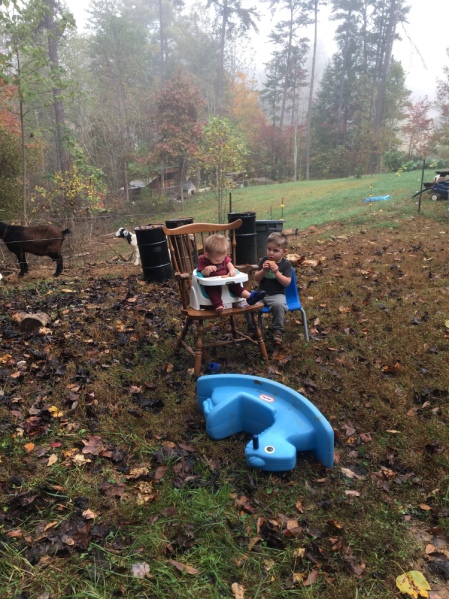“Monday Was Wash Day”: How to Do Laundry The Primitive Way
It seems that every person I’ve talked to about doing laundry the old-fashioned way said that their Mama did it on Monday.
To me, that is a crummy way to start the week.
Wash on Mondays
My papaw Wes said his mother was always hateful on wash day. I always answer him, “No wonder!”.
I really wanted to get the feel for this way of doing laundry. On a fairly sunny day at the end of October, I tried it.
Every now and then I become very discouraged by our modern conveniences. I used to think that having a little cabin without electricity at all would be so idyllic. I don’t know if idyllic is the right word…more like back breaking constant work! So I came to the conclusion to be thankful for these conveniences instead of cursing them all the time.
I could make it pretty fair on a wood burning cookstove…we’d survive with no air conditioner…I do my dishes without a dishwasher…but doing laundry without a washer and dryer? I’d rather not. Here’s my journey through primitive wash day.
What You Need for Primitive Laundry Day
My resources for this little project was from what I heard from my grandparents, and notes from Foxfire 2. (Check out my affiliate link on Amazon to purchase these Appalachian treasures.)
Wash Day necessities:
-Iron wash pots (or copper or aluminum was used)
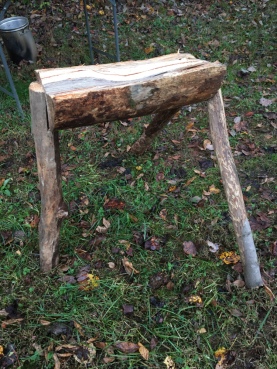
-Battling board and battling stick (rough chopped bench made from a log. Keep the top ridges rough so the dirt can run off easier.)
-One long thick stick
-Soap
-Clothesline
-Plenty of water
-Kids for free labor (Just kidding…but optional)
How to Wash The Old Fashioned Way
1. Get started early. Fill your pot with clean water. (I cheated here, I had a water hose. I didn’t have to tote it bucket by bucket from the spring or creek. According to Papaw, this was the kids’ jobs anyway.)
You’ll need at least two big iron pots. One to put over the fire, and one to rinse. It is recommended to have another pot for a second rinse. (I just had two.)
2. Make a hot fire under pot #1, and bring the water to a boil…or almost boil. When the water is hot enough, drop in a bar of soap. I used my homemade lye soap to be authentic!
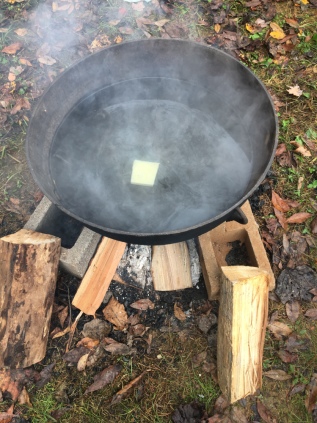
3. Then, put in your clothes, and use the long thick stick aforementioned to stir them around. I stirred and tossed them around for several minutes.
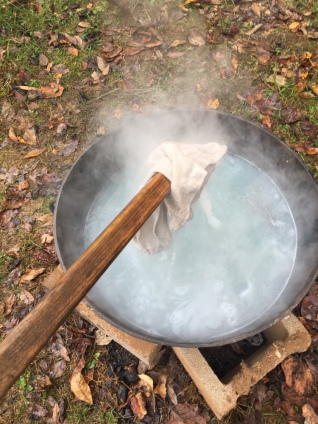
4. Taking out one article of clothing at a time, slap them on the battling bench. Use the battling stick to beat the dirt out of the clothes. Ridged washing boards were used, too. Since I’m doing this pretty primitively, I opted for the battling bench instead of the board. It’s the same concept, though.
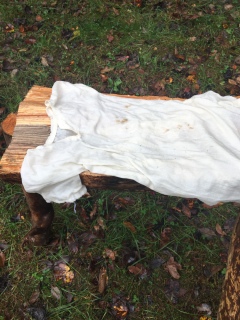
Side note: I’ll take a minute to comment on the clothing I used for this experiment. I used our mostly cotton material-ed clothing we used to re-enact down at Fort Loudoun State Historic Site. So it was pretty thin…and my little boys things were pretty dirty, and the battling stick actually did help knock the grime out. (I’ve since made the historical switch to linen after a few months of research and sewing new clothing, but that’s a whole different topic.)
Oops I messed up here:
Here was the bad part: I had not pre-washed their little checkered neck kerchiefs (pretty much like a bandana) and the green dye started to leach. I was afraid it might stain my more natural colored clothing, so I got them out before everything started to turn green!
5. Put the battled clothing into rinse pot #2. This pot is not on the fire. But it is set close to make the switch from battling bench to pot easy. Stir it to rinse well. Traditionally, another rinse pot would be set up for another rinse. I skimped here…because I could refill quickly with the water hose.
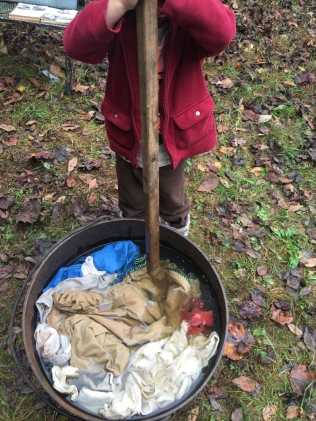
6. Once the clothes are rinsed well, take them out and set them on the line. Wringing methods are debatable. In later years of course you could have a wringer that you ran the clothes through. There were even electric ringers on the market. You could wring them with your hands (this makes for very tired hands), or just slap the wet clothing on the line and go on. I chose the third method but gave them a quick wring to not be so dripping wet.
7. The clothes will dry after being on the line all day. They will also be extremely wrinkled!
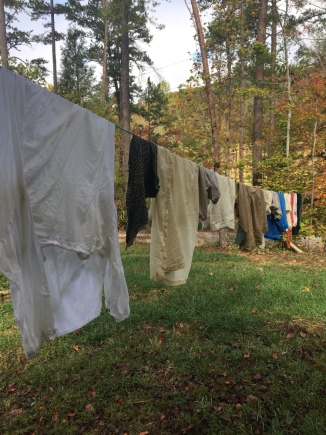
8. I hate the thoughts of having to iron clothes the way my great-grandmothers would have after the long afternoon of standing around the wash-yard.
But if I did…I’d have to heat my iron…iron every piece of clothing…and put it up neatly. I’m sorry to say this chore and my personality do not mesh well.
So I didn’t iron my clothes. Instead, I cheated big time and popped them into my dryer for the finish.
The Results of My Experiment
I’m so very glad I did this. And I’ll probably do it again, just for fun. (I know, I’m a little crazy.) I am however, very thankful I don’t have to do this every week.
There are several observations I want to mention about laundry:
- Our ancestors did not have a billion articles of clothing like we do today. It would make laundry so much easier if we each had a few tops, a few bottoms, little underwear, and a few socks. The laundry pile of yesteryear was not as formidable as todays, I’m sure.
- Having older children to help during washday would make it a much easier chore as well. One woman doing the whole thing would be very tiring. I don’t see how women survived it alone. My great grandmother Minnie told her children that she had to stay home from school, her and her sisters, to help their mother with the wash. From the mother’s viewpoint…I don’t blame her for holding her girls back from morning lessons. I would have demanded the help, too. But as a daughter it might seem unfair to have to miss school to help with such a chore.
- If everyone you knew wore the same clothes several days in a row…no one would know you smelled a little funny, because everyone smelled the same. So… no Gain fresh scent was wafting around during those days.
- In an emergency situation, of course the clothes could be washed out quickly in some clean water and a little soap. You wouldn’t always need to wait a whole week for the big event. But it couldn’t be dried in less than an hour. I don’t know how many times I’ve spent only a couple hours washing and drying a load of clothing that contained jeans I needed for the day. That wouldn’t have been a reality 100 years ago.
- Photo credits go to my little four-year-old boy. The younger brothers enjoyed playing around outside while I did the chore. I pity the women who had to care for little ones while doing laundry. Their nerves and muscles both had to be shot. Thank goodness for laundry machines we have today!
